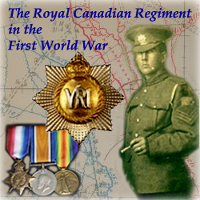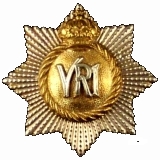
The First World War
War Diary of The Royal Canadian Regiment
Transcription by Captain Michael O'Leary, The RCR.
JULY 1917
APPENDIX 10
A BRIEF STORY OF THE HISTORY OF THE ROYAL CANADIAN REGIMENT;
FOR THE USE OF INSTRUCTORS
The Royal Canadian Regiment was born on the 21st December, 1883 and was christened the Infantry School Corps.
It was originally intended to instruct the Canadian Citizens Forces in that branch of the Service, which it continued to do until about the 30th July 1914 when we were ordered to our War Stations.
Between these two dates we fought in two Campaigns - 1885 in the North West Rebellion and 1899 - 1900 South Africa. In 1885 we served under General MIDDLETON and did good work at BATOCHE and CUT KNIFE CREEK. At CUT KNIFE CREEK we were commanded by ALIBABA SMITH (so called because his men stole everything they could). We suffered heavy casualties.
We were duly rewarded by winning our first battle honours for our Colours. They were "SASKATCHEWAN" and "NORTH WEST REBELLION".
After this campaign we settled down again in our depots and in 1899 we went to SOUTH AFRICA, where we served under Colonel W.D. OTTER.
We were in the 19TH Brigade, 9TH Division, under major General COLVILLE and served alongside the GORDONS, SHROPSHIRES, and DUKE OF CORNWALL'S LIGHT INFANTRY.
We were in many fights,- the successful expedition to SUNNYSIDE being the first. We distinguished ourselves especially at PAARDEBURG [sic], where we charges with the bayonet with the CORNWALL'S, but were held up and suffered considerable casualties from heavy rifle and Machine Gun fire.
After this war we returned to CANADA and in 1905 we took over the defences at HALIFAX from the 5TH ROYAL GARRISON REGIMENT.
Our establishment being augmented we then had six Companies in Halifax and four in depots.
On the 16th September 1914 we were sent to BERMUDA to relieve the 2ND Battalion of the LINCOLNS.
We all thought we should only be there for a month or two, but instead of which, to our great dismay we were kept there until the 13th August 1915, when we embarked for FRANCE via HALIFAX and PLYMOUTH. On arrival at SHORECLIFFE Lieut-Colonel (now Brigadier general) A.H. MACDONNELL, C.M.G., D.S.O., took over command of the Regiment. We remained in ENGLAND undergoing training in TRENCH WARFARE etc. until the 31st of October 1915., on which date we embarked for FRANCE. On arrival in FRANCE we were Corps Troops for some time but were shortly BRIGADED with the PRINCESS PATRICIA'S CANADIAN LIGHT INFANTRY, 42ND BATTALION (Royal Highlanders of Canada), 49TH BATTALION (Edmonton Regiment), the whole forming the 7TH CANADIAN INFANTRY BRIGADE under Command of BRIGADIER GENERAL (Now Major General) A.C. MACDONELL, C.B., C.M.G., D.S.O., and were posted to the 3RD Canadian Division.
On the 20th April 1916 Lieut-Colonel C.H. HILL, D.S.O., took over Command of the Regiment from Lieut-Colonel MACDONELL.
Our first fight of any importance was the 3rd Battle of YPRES on the 2nd June 1916 when, after a four hours intensive bombardment from a large number of guns of all calibres, we were heavily attacked three times in succession by the Enemy. We repulsed all three attacks by our rifle and Machine Gun fire with heavy loss to the Enemy. Our losses were approximately 250 all ranks.
In this battle (which extended along practically the whole of the Canadian Corps front) we were the extreme left flank of the Corps, - the P.P.C.L.I. being on our right; and the 8TH Canadian Brigade on the right of the PPCLI. Unfortunately the Units on our right were temporarily compelled to give ground. No enemy troops, however, were able to penetrate our own battalion frontage. All the territory lost was eventually retaken by the Canadians.
After this battle we had to go back to a rearward area to refit and reorganize.
Our next actions were on the SOMME on the 15/16th September 1916, on the 2nd October 1916 and finally on the 8th October 1916 when we attacked the well known REGINA Trench. We were the only regiment in the Division which got to their objective from which, however, we were eventually blown out, returning at 5.00 p.m. the same night with a trench strength of 81 by actual count., "A" Company having only 5 men left.
Our Trench Strength when we arrived in the SOMME Area was 719 all ranks. On September 15/16th, our casualties were 4 officers and 257 other ranks. On October 2nd, our casualties were 5 Officers and 83 other ranks, and October 8th they were 12 Officers and 277 other ranks,- making a total for the three tours of 21 officers and 617 other ranks.
On the 9th April 1917, we took part in the capture of VIMY RIDGE, which we think was the most complete success that has fallen to our arms since the beginning of the War. We were opposite the 2ND battalion of the 262ND R.I.R. They were entirely wiped out; those not buried in their dugouts were either killed or captured, including the Battalion Commander, his Adjutant and Quartermaster.
Our casualties were 13 Officers and 290 other ranks, which was not considered heavy. We launched the attack with 649 all ranks.
But back to our Colours. After the South African Campaign King Edward VII, in recognition of our services, presented us with a third Colour (another King's Colour). We had our original two, the REGIMENTAL and the KING'S. There are very few regiments in the British Service who can boast of three Colours and we are justly proud of it.
Another thing we are proud of is our CAP BADGE, which was given to us by the late QUEEN VICTORIA as a Birthday present; it is the Universal pattern and has on it the letters V.R.I. which mean VICTORIA QUEEN AND EMPRESS OF INDIA.
We also wear V.R.I. on our buttons.
The COLLAR BADGE is a Canadian beaver which is indicative of Industry.
The Honorary Colonel at present is HIS ROYAL HIGHNESS THE DUKE OF CONNAUGHT. Our Original Honorary Colonel was the late LORD WOLSELEY.
The LIENSTER REGIMENT is called "ROYAL CANADIANS" as they were originally raised in CANADA.
We, however are THE ROYAL CANADIANS,- a distinction that must not be overlooked.
The band of the Regiment was selected to represent the DOMINION OF CANADA at the Coronation of KING GEORGE V. It proceeded to ENGLAND with a Composite battalion, in which we had, in addition to the Band, 50 representatives.
Our Regimental depot is in HALIFAX, NOVA SCOTIA, where our COLOURS and PLATE are at present.
All our reinforcements now come from the 26TH Canadian Reserve Battalion, Bramshott, which is under the Command of Major A.W.P. WESTON, formerly 25TH Canadian Battalion, 2ND Canadian Division. The reserve battalion is also known as the NOVA SCOTIA Battalion, as all their men come from Nova Scotia. In addition to reinforcing us the reserve battalion reinforces the 25TH Canadian Battalion.
- The O'Leary Collection; Medals of The Royal Canadian Regiment.
- Researching Canadian Soldiers of the First World War
- Researching The Royal Canadian Regiment
- The RCR in the First World War
- Badges of The RCR
- The Senior Subaltern
- The Minute Book (blog)
- Rogue Papers
- Tactical Primers
- The Regimental Library
- Battle Honours
- Perpetuation of the CEF
- A Miscellany
- Quotes
- The Frontenac Times
- Site Map

![]() The RCR in the Great War
The RCR in the Great War
![]() War Diary
War Diary
![]() Battle Honours
Battle Honours
![]() Battle Bars and The RCR
Battle Bars and The RCR
![]() The RCR Battle Bar Ledger (pdf)
The RCR Battle Bar Ledger (pdf)
![]() Honours and Awards
Honours and Awards
![]() Roll of Honour
Roll of Honour
![]() Prisoners of War
Prisoners of War
![]() Cemetery List
Cemetery List
![]() Cemetery Map
Cemetery Map
![]() Courts Martial
Courts Martial
![]() Officers
Officers
![]() RSMs of The RCR (1914-1919)
RSMs of The RCR (1914-1919)
![]() NCOs and Soldiers
NCOs and Soldiers
![]() An Officer's Diary (1914-1918)
An Officer's Diary (1914-1918)
![]() Recollections of a Nonagenerian (R. England) (1916-1919)
Recollections of a Nonagenerian (R. England) (1916-1919)
![]() On to Bermuda (1914-15)
On to Bermuda (1914-15)
![]() England and France 1915-1916 (Hayes; 1931)
England and France 1915-1916 (Hayes; 1931)
![]() Overseas with The Royals (1915)
Overseas with The Royals (1915)
![]() Regimental History Pamphlet (1917)
Regimental History Pamphlet (1917)
![]() Amiens (1918)
Amiens (1918)
![]() Cambrai (1918)
Cambrai (1918)
![]() Monchy-le-Preux (1918)
Monchy-le-Preux (1918)
![]() Under-aged Soldiers in The RCR
Under-aged Soldiers in The RCR
![]() Not All Were Volunteers; The RCR and the Military Service Act
Not All Were Volunteers; The RCR and the Military Service Act
![]() Sentenced to Death by Court Martial
Sentenced to Death by Court Martial
![]() The 7th Trench Mortar Battery
The 7th Trench Mortar Battery
![]() A Regimental Goat
A Regimental Goat
![]() Regiment and Family, Bermuda 1914-15
Regiment and Family, Bermuda 1914-15
![]() "March the Guilty Bastard In"
"March the Guilty Bastard In"
![]() Surrendered as Stowaway
Surrendered as Stowaway
![]() Re-Visiting the Great War Roll of Honour for The RCR
Re-Visiting the Great War Roll of Honour for The RCR
![]() Canadian Corps Trench Standing Orders (1916)
Canadian Corps Trench Standing Orders (1916)

